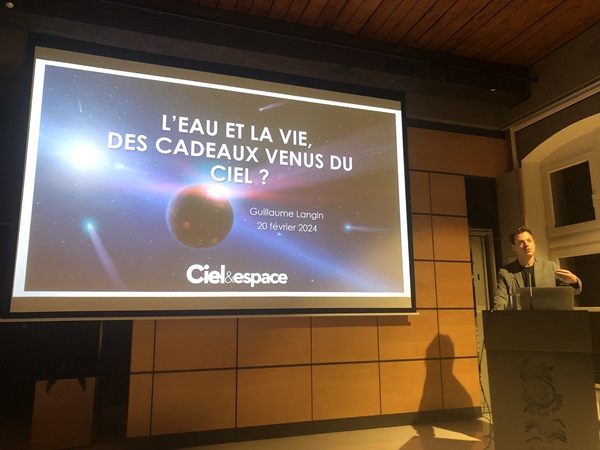 Guillaume Langin, science journalist from Paris-based astronomy magazine Ciel&Espace;
Credit: Otilia Dragan/Chronicle.lu
Guillaume Langin, science journalist from Paris-based astronomy magazine Ciel&Espace;
Credit: Otilia Dragan/Chronicle.lu
On the evening of 20 February 2024, Guillaume Langin, a science journalist from the Paris-based Ciel&Espace (sky&space) astronomy magazine, held a presentation at the Luxembourg Museum of Natural History (MNHN) in Luxembourg-Grund; the topic of discussion was the possibility of water and life being transported to Earth by meteorites.
Guillaume Langin added that wondering about the cosmos came naturally to him as the philosophical question “What am I doing here” and that most studies exploring space are concerned with three main questions: “What is our past,” “What is our future” and “Are we alone?”
His presentation focused on the question of whether water and life, and perhaps the “ingredients” for them were already on Earth or whether meteorites brought them here in their fall.
He started by showing a short clip which gave an overview of the universe’s formation. 13.8 billion years condensed into a short film, showing the Big Bang, the expansion, first stars and their death, galaxies forming, the fusion of two continuing to combine into one, the formation of a black hole, star death and rebirth, the birth of the sun, formation of the earth and the moon, the Hadean and Archean Eons, followed the formation of water, early life forms, the oxygenation of atmosphere, followed by the ice age and very fast succession of flora and fauna appearing.
The focal point of the evening’s presentation was the formation of the earth, 4,5 to 5 billion years ago, and also the fact that the science community continually finds new information. For instance, on 7 August 1976, Viking, a lander and an orbiter designed to take high-resolution images, and study the Martian surface took an image of Mars for the first time, clarified that the planet did not show any signs of the presence of life (or little green aliens) as was previously rumoured. On 7 December 1972, the “blue ball” photo was taken on Apollo 17, showing the earth from outer space for the first time.
Discussing the possibility that asteroids carried water to the early earth, Guillaume Langin noted the fact that despite its blue appearance, only 0,1% of its total mass is water – only the earth’s surface is covered in water. He went on to explain that meteorites fall massively on earth – 5200 tonnes per year (equivalent to 1000 elephants), including micrometeorites and cosmic dust. Only 10 tonnes of this amount are large meteorites. One particular kind of meteorite (chondrites) contains significant amounts of water, and the further it comes from, the richer in water a meteorite will be.
Comets are very rich in water, but their trajectory showed that not enough of them would have reached the Earth, he noted. Furthermore, the water components in asteroids are the same as those found in water molecules on Earth. On Earth, 1 in 6667 water molecules is semiheavy, while on carbonaceous asteroids, the ratio remains the same. However, on comets, the proportion increases to 2 in 6667 molecules. For this reason, it was long thought that asteroids (called meteorites once they hit the Earth) delivered the Earth’s water. However, newer studies revealed that hydrogen inside the Earth interacting with its magma oceans during the planet’s formative years likely played a role in the formation of the ocean.
While the two theories are not mutually exclusive, Guillaume Langin emphasised the importance of "doubt" in the scientific community. New information is delivered to us directly from asteroids nowadays, he explained, adding that in 2018, Japan sent a spacecraft to the Ryugu asteroid that returned a sample capsule to Earth on 5 December 2020. Such samples, even microsamples, allow a much better grasp of asteroids’ components and provide critical pure materials lacking from meteorite collections.








